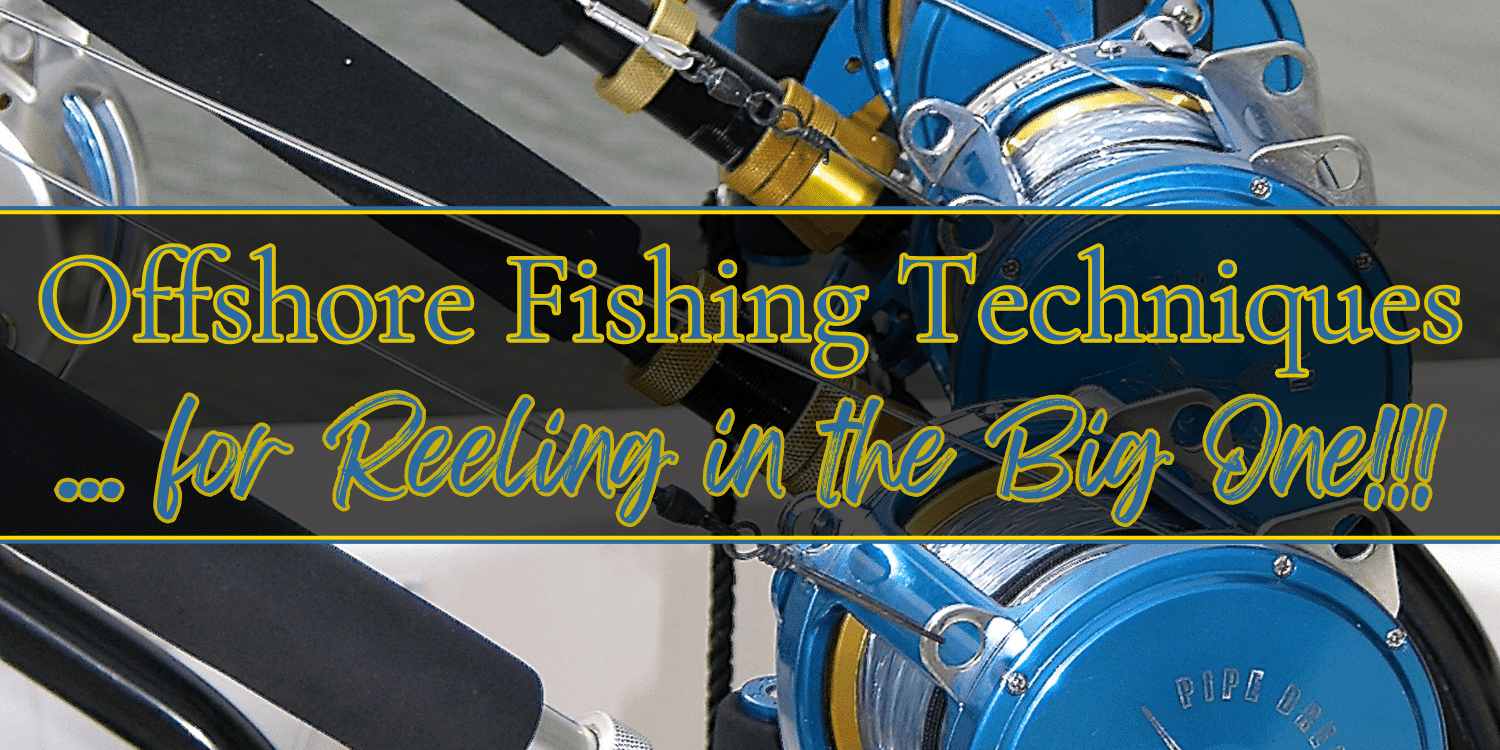Are you ready to level up your fishing game and embark on an exhilarating offshore adventure? Picture yourself casting your line into the vast open waters. The anticipation building as you wait for that thrilling tug on your rod. Offshore fishing offers a world of excitement, where you can target big game fish and challenge your angling skills.
Here, we’ll delve into the art of offshore fishing and explore some effective techniques to help you land those impressive catches. These tips will give you the edge you need to succeed on your next offshore fishing trip.
Research and Prep
Before setting off on your offshore fishing adventure, it’s crucial to do your homework and make the necessary preparations. Here are some key points to consider:
- Know Your Target Species: Research the specific fish species you want to target. Learn about their habits, preferred habitats, feeding patterns, and migration routes. This knowledge will help you determine the best locations and techniques to increase your chances of success.
- Weather and Fishing Conditions: Keep a close eye on weather forecasts and understand how different conditions can affect offshore fishing. Wind direction, tide levels, water temperature, and moon phases all play a role. Plan your trips during favorable conditions for better fishing opportunities.
- Local Regulations and Permits: Familiarize yourself with the local fishing regulations and obtain the necessary permits. Ensure you’re aware of size and bag limits, restricted areas, and any seasonal closures. Responsible fishing ensures the sustainability of fish populations and protects the ecosystem.
- Safety Precautions: Offshore fishing can be challenging and unpredictable. Prioritize safety by ensuring there’s proper gear on the boat. Keep an eye on changing weather patterns and be prepared to return to shore if necessary.
- Tackle and Gear: Select the appropriate fishing tackle and gear based on your target species and fishing techniques. Offshore fishing often requires robust rods, reels, lines, leaders, and sturdy hooks. Stock up on a variety of baits and lures suitable for different conditions.
- Timing and Fishing Seasons: Timing is key in offshore fishing. Different species have peak seasons when they are more abundant and actively feeding. Plan your trips accordingly to maximize your chances of encountering your desired catch.
By conducting research and preparing, you’ll be equipped to make the most of your offshore fishing adventure.
Trolling Technique
Trolling is a widely used technique in offshore fishing that involves dragging fishing lines behind a moving boat. This method allows you to cover a larger area and present your bait or lures at various depths to attract fish. Here’s what you need to know about trolling:
- Choosing the Right Trolling Lures and Baits: Select lures and baits that closely resemble the fish species you’re targeting. Consider factors such as color, size, and swimming action. Popular trolling lures include diving plugs, spoons, and artificial squid.
- Setting Up Trolling Lines: Rig your trolling lines with appropriate leaders and hooks. Use wire leaders for toothy predators like king mackerel or wahoo. For other species, monofilament or fluorocarbon leaders work well. Space your lines at different distances behind the boat to cover various depths.
- Adjusting Speed: Experiment with boat speed to find the optimal trolling speed for your target species. A speed between 4 to 8 knots is a good starting point. Adjust your speed based on fish activity, sea conditions, and the type of lure you’re using.
- Varying Depths and Patterns: Use downriggers, planers, or diving devices to vary the depths at which your lures swim. This technique allows you to target fish at different water levels simultaneously. Change lure positions and patterns regularly to mimic the movement of a school of fish.
Trolling is an effective technique for targeting species like mahi-mahi, tuna, and billfish. It provides an opportunity to cover a large area of water and entice predators to strike. Stay tuned for the upcoming sections where we’ll explore more offshore fishing techniques to add to your angling arsenal.
Bottom Fishing Technique
Bottom fishing is a popular offshore technique that involves targeting fish species that dwell near the ocean floor. This technique can yield impressive catches such as snapper, grouper, and various bottom-dwelling species. Here’s what you need to know about bottom fishing:
- Selecting the Appropriate Rigs, Hooks, and Weights: Choose rigs suitable for bottom fishing. These include fish finder rigs and knocker rigs. Use strong and sharp hooks that match the size of your target species. Attach sinkers or weights to your rig to help it reach the desired depth.
- Identifying Suitable Structures and Areas: Look for underwater structures such as reefs, wrecks, and ledges. These structures attract fish seeking shelter and feeding opportunities. Research charts or consult local experts to locate productive bottom fishing spots.
- Techniques for Presenting Baits Effectively: Use fresh or live bait that appeals to bottom-dwelling fish. Cut baits like squid, mullet, or shrimp work well. Present your bait near the bottom by casting or dropping your line directly over the targeted structure. Allow your bait to settle, and periodically lift and drop it to create enticing movements.
- Detecting Bites and Hooking Fish: Be attentive to subtle bites and changes in your line tension. Bottom-dwelling fish may nibble or take the bait more gently than surface-feeding species. When you feel a bite, give a firm hookset to secure the fish.
Bottom fishing can be a rewarding technique, offering the chance to reel in some impressive and delicious catches. Stay tuned for the upcoming sections where we’ll explore more offshore fishing techniques to enhance your angling skills.

Live Bait Technique
Using live bait can be highly effective in offshore fishing. It entices predatory fish with the irresistible movements and scent of live prey. Here’s what you need to know about live bait fishing:
- Selecting and Handling Live Bait: Choose lively and healthy baitfish such as pinfish or mullet. Keep them in a well-oxygenated baitwell or livewell to maintain their vitality. Avoid overcrowding, as it can lead to stress or injury to the baitfish.
- Rigging Live Bait: Use appropriate rigs and hooks for live bait fishing. Options include a free-line rig, Carolina rig, or a live bait under a popping cork. Ensure your hooks are sharp and suitable for the size of the baitfish. Position the hook carefully to allow for natural movement.
- Presenting Live Bait: Cast or release your live bait near structures, reefs, or other areas known to hold fish. Allow the baitfish to swim freely and naturally. Pay attention to signs of distress or predator activity, as they can indicate the presence of game fish.
- Maintaining Bait Movement: Encourage your live bait to swim actively by allowing it space and avoiding excessive drag from your line. Use a slow retrieval or gentle movements to keep the baitfish lively and attract nearby predators.
Live bait fishing can be highly productive, enticing a wide range of offshore species. It provides an authentic presentation that can entice even the most cautious fish. Stay tuned for the upcoming sections where we’ll explore more offshore fishing techniques to enhance your angling skills.
Jigging Technique
Jigging is a versatile and dynamic technique that involves using a weighted lure, known as a jig. The jig imitates prey and entices fish to strike. Here’s what you need to know about jigging:
- Selecting the Right Jig: Choose jigs that match the size, shape, and color of the fish’s natural prey. Consider factors such as water depth, target species, and current conditions. Options include vertical jigs, butterfly jigs, or bucktail jigs.
- Mastering Jigging Techniques: Master various jigging techniques, including vertical jigging, yo-yo jigging, and flutter jigging. Vary your retrieval speed, impart erratic movements, and occasionally pause to mimic injured or fleeing prey.
- Reading the Sonar and Identifying Fish: Use a fishfinder or sonar to identify the presence of fish and locate their depth. Look for fish arches, baitfish schools, or structure-related marks. Jigging near these areas increases your chances of attracting predatory fish.
- Adapting to Depth and Conditions: Adjust your jig weight to reach the desired depth. Also, maintain contact with the bottom or target zone. Consider current and water movement when selecting the appropriate jig weight and shape. Adapt your technique based on fish response and environmental factors.
- Experimenting with Jig Colors and Styles: Try different colors and styles of jigs. You can determine what works best for the target species and prevailing conditions. Bright and flashy colors can attract fish in murky waters. Natural or subdued colors may be more effective in clear conditions.
Jigging is a dynamic and engaging technique that can yield impressive results in offshore fishing. It allows you to cover various depths and entice a wide range of fish species. Stay tuned for the upcoming sections where we’ll explore more offshore fishing techniques to enhance your angling skills.
Chumming Technique
Chumming attracts fish by dispersing a mixture of bait, fish parts, or other scent-enhancing substances into the water. This method can create a feeding frenzy, enticing fish to gather and bite. Here’s what you need to know about chumming:
- Selecting the Right Chum: Choose chum that is appropriate for the target species and the fishing location. Options include ground fish, shrimp heads, or commercial chum products. Consider the scent, texture, and dispersal rate of the chum.
- Creating a Chum Slick: Establish a chum slick by regularly dispersing small amounts of chum into the water. Use a chum bag, bucket, or mesh container to control the release of the chum. Distribute it upcurrent or near the fishing spot to allow the scent to drift towards the fish.
- Using Chumming Techniques: Employ different chumming techniques, such as chunking or slinging, depending on the target species and fishing conditions. Chunking involves cutting bait into chunks and tossing them into the water. Slinging involves using a chum dispenser to propel the chum away from the boat.
- Observing Fish Behavior: Pay attention to fish behavior and response to the chum. Look for signs of increased activity, such as fish breaking the surface or birds diving. Adjust the rate and type of chumming based on the fish’s preference and feeding patterns.
- Presenting Baits in the Chum Slick: Place your baits within the chum slick to maximize their visibility and scent. Allow the baits to drift naturally or use appropriate rigs to keep them within the desired feeding zone. Be ready for quick strikes as fish are drawn to the chum.
Chumming can be a highly effective technique to attract and concentrate fish in a specific area. It creates an enticing feeding environment that increases your chances of success.
Call me!
As an offshore angler, I’ve shared with you some valuable techniques to enhance your fishing adventures. Whether you’re chumming, trolling, or using live bait, these techniques can help you reel in those prized catches. Now it’s time to put your newfound knowledge into action!
Take to the waters of Venice, Louisiana, with Louisiana Offshore Fishing Charters and experience the thrill of offshore fishing firsthand. Embrace these techniques, adapt them to your own style, and make unforgettable memories as you reel in trophy fish. Get ready to embark on an angling journey like no other!
Remember, practice makes perfect, and each outing is a chance to learn and improve. So gather your gear, assemble your crew, and get ready to conquer the offshore waters of Venice. Captain Troy is here to guide you and make your fishing dreams a reality.
Don’t wait! Book your offshore fishing charter today and let the adventure begin!



